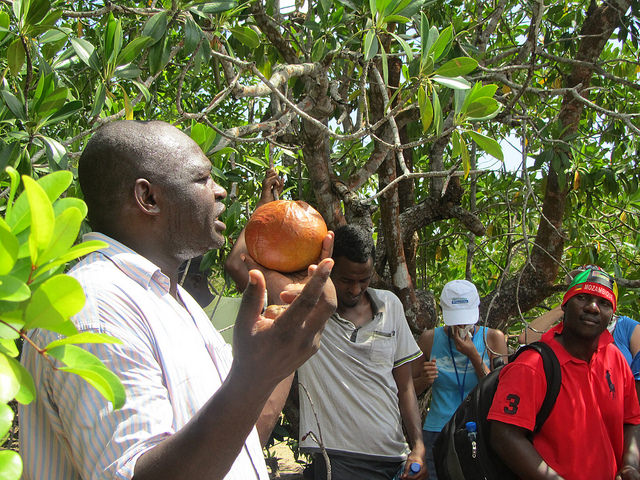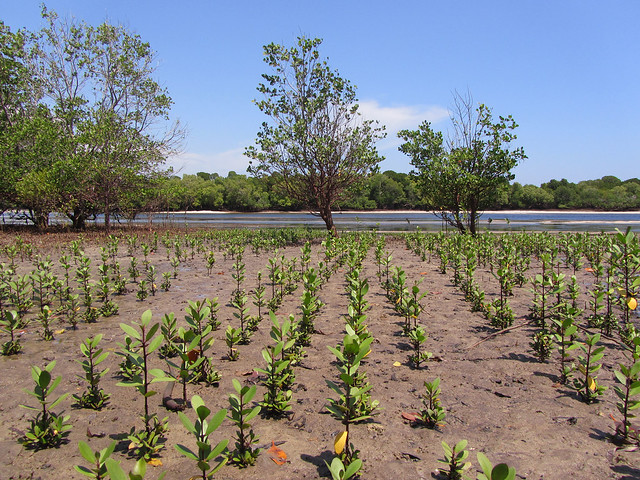http://e-info.org.tw/node/115796
生態旅遊當副業 肯亞漁民著手復育紅樹林
文字大小
27 1 Share1

本報2016年6月2日綜合外電報導,陳瀰真編譯;鍾友珊審校
肯亞東岸沿海的加茲( Gazi )社區,正藉由紅樹林的復育和碳交易計畫,對抗氣候變遷對生活的影響。
位在肯亞第二大城蒙巴薩(Mombasa)南部約48公里的加茲村,是一個東鄰印度洋的小漁村。當地的社區組織,結合了紅樹林的復育與碳交易,發展出兼顧漁民生計與生態旅遊的永續經濟模式。
當地居民在平日到沿岸進行漁貨買賣;雨季時,則會有三天不做漁貨生意,改種紅樹林。村中每戶都有一個代表參與這樣的模式,因為他們發現,紅樹林的復育能夠使當地居民的生計永續,也能夠減緩氣候變遷的影響。
紅樹林在當地生活與生態扮演重要角色。它們既是當地居民興建房屋、製作家具、漁船甚至廟宇的木材來源,在維護海岸生態方面,紅樹林也提供理想的遮蔽環境,使魚群免於強烈水流的衝擊和掠食者的威脅。
當地社區參與紅樹林復育計畫,主要由肯亞海洋與漁業研究機構所發起,其在加茲村中心的辦公室已成立逾十年,致力於紅樹林的復育。當地紅樹林退化的原因,主要和過去的農業活動、商業伐木,以及石灰業使用紅樹林的樹木當燃料有關。機構嘗試將科學融入社區發展,讓居民能參與復育。

社區居民進行紅樹林復育訓練。圖片來源:Blue Forests(CC BY-NC-ND 2.0)。
不過,一開始要說服居民投入復育並不容易,主因在於居民沒有氣候變遷的概念。研究員裘格( Njoroge ) 表示,經過數次的集會討論,居民才漸漸意識氣候變遷的問題,對復育紅樹林的態度轉為積極,組成自治組織米寇寇‧帕摩亞( Mikoko Pamoja,即「與紅樹林一起」之意)。如今,該社區甚至經營生態旅遊,帶遊客認識紅樹林(肯亞境內九種紅樹林中,加茲就能看到六種),並在社區內經營餐廳,供應遊客斯瓦希里 (Swahili)菜餚。
紅樹林在當地還有另一項重要功能──作為碳匯 (carbon sink)。事實上,加茲社區的保育計畫是受到一個2013年發起的碳補償計畫(carbon offsetting)的支持。按計畫,社區每年必須在紅樹林退化的區域種植四千株的樹苗,種植面積相當於一 公頃;同時保育現存的林區。該計畫允許社區在未來的20年,每年售出3000噸的二氧化碳排量;社區在過去兩年已因此獲得25000美元的收益。
目前碳排量的買主包括:全球環境監測計畫(Earthwatch)、比利時的尼可寇丹(Nico Koedem) 研究團隊、倫敦大學帝國學院的研究生。因販售碳排量而獲得的經費收益,也用來支持當地社區的發展計畫,如翻修教室,或在附近社區鑿洞將乾淨的水引入社區。
當地的研究員現正構思將加茲社區結合紅樹林復育、生態保育與碳補償計畫的成功模式,推廣到肯亞沿岸其他有紅樹林分布的社區。當地居民穆罕默德(Mohamed)表示,這樣的合作復育模式對於社區有深遠的影響:「身為漁民,我因此捕到更多的魚。而社區因照顧紅樹林而獲得的經費則讓我們取得乾淨用水和整修教室...也許將來還可以蓋家醫院。」
The coastal Kenyan villages bringing their mangrove forest back to life
A community on Kenya’s east coast is fighting climate change with its own mangrove restoration, conservation and carbon-trading project
Around 30 miles south of Mombasa, a beaten footpath stretches away from the main road, meanders around shrubs and coconut trees, and leads into Gazi village. The small settlement of mud-walled houses and a few shops extends up to the edge of a mangrove forest, which itself gives way to the vast Indian Ocean.
Villagers from Gazi and the neighbouring settlement of Makogeni meet on these shorelines every day to trade fish. From 11am, women congregate in Gazi Bay to buy catch from the fishermen, who arrive back on shore after hours out at sea.
But for three days every rainy season, the fish trade is set aside and the villagers come together to plant mangroves instead. It’s a communal affair where at least one member of every family is involved.
Fisherman Omar Mohamed hasn’t missed a single mangrove planting session for four years and was among those who planted 4,000 seedlings in November.
“Since we started caring for the mangroves, we harvest more and more fish,” he says. “Now, fishermen from as far off as Pemba [an island of the Zanzibar archipelago] come to fish here.”
Mohamed belongs to the community organisation that was formed in 2009 to contribute towards the restoration of the mangroves, which had been degraded by community activities, licensed commercial loggers, and chalk manufacturing industries which used the mangroves as firewood.
Mangroves are essential for villages like Gazi and Makogeni whose inhabitants rely on the forests to build houses, furniture, boats and to use as firewood. Some villagers who still ascribe to the traditional Digos religion have erected shrines inside the forest. Mangroves also act as carbon sinks and, most importantly for the fishermen, they are a vital coastal ecosystem.
“Fish rarely breed in the deep sea because the conditions are hostile. Fish prefer mangrove environments so they are protected against predation and strong water currents,” says Michael Njoroge, a researcher for the Kenya Marines and Fisheries Research Institute. Restoration of the mangroves was essential, not only to secure sustainable livelihoods for the community, but to mitigate the effects of climate change.
The community group was spurred into action thanks to research by the Kenya Marines and Fisheries Research Institute, which has an office in the centre of Gazi. For more than a decade, researchers based here have been working to reverse the degradation of the mangroves and to link science to community development, by engaging the villagers in their restoration. At first, says Njoroge, it wasn’t easy to persuade the local community to buy into the programme because they didn’t understand climate change.
However, after researchers from Kemfri held community meetings to create awareness on climate change, all the villagers embraced the idea and formed their own organisation, which they named Mikoko Pamoja – Swahili for “mangroves together”.
Today, Mikoko Pamoja even has its own ecotourism unit, featuring 450 metres of boardwalk among the trees where six of the nine mangroves species in Kenya can be seen. The community also runs a restaurant serving Swahili food to tourists.
“Planting and taking care of the mangrove trees has ensured that visitors come to our boardwalk where they can see the different species of mangroves, and they can enjoy the view of the forest and the ocean,” says Mwatime Hamadi, a tour guide at the ecotourism unit.
The community’s conservation efforts are aided by the development of a carbon offsetting project, launched in 2013. “Through the programme, the community must plant 4,000 seedlings – an equivalent of 0.4 hectares (1 acre) – every year at the degraded sites, in addition to conserving the existing forest,” says Njoroge. In return, Mikoko Pamoja has been verified to sell 3,000 tonnes of CO2 per year over 20 years. In the past two years, the community has made $25,000. The buyers of Mikoko Pamoja’s carbon credits include Earthwatch, the Nico Koedem research group, and MSc students from Imperial College London. The Association of Coastal Ecosystem Services connects the buyers to Mikoko Pamoja.
“Money generated from the sale of carbon credits goes towards the support of development projects in the community,” says Salim Mmwarima, project coordinator for Mikoko Pamoja. “In 2014, we renovated classrooms, and in 2015 we used the proceeds to pipe clean water into the villages from a borehole in a neighbouring village.”
The researchers from Kemfri are now looking to scale up the various reforestation, conservation and carbon offsetting projects to other parts of the Kenyan coastline where mangroves grow.
“Currently, plans are under way to start such a project in Vanga [and] there have been requests from other communities along the coast for technical support to start such a project too,” said Njoroge.
As Mohamed points out, such projects have a substantial impact on communities: “As a fisherman, I catch more fish [and] the money we get from taking care of the mangroves helps us as a community to get access to clean water and repair schools ... maybe next time we’ll build a hospital.”
Join our community of development professionals and humanitarians. Follow@GuardianGDP on Twitter, and have your say on issues around water in development using #H2Oideas.





沒有留言:
張貼留言